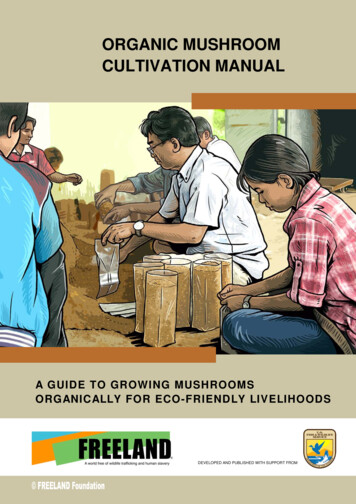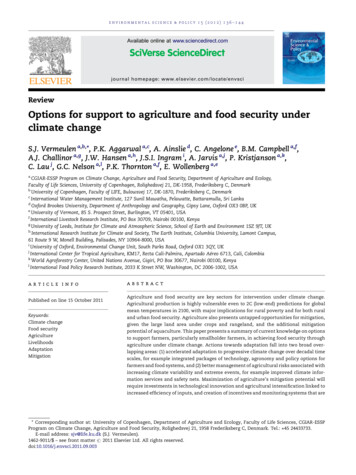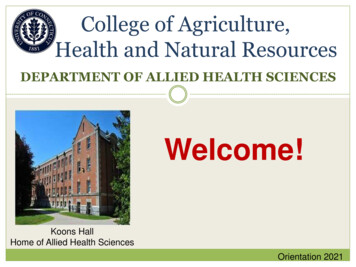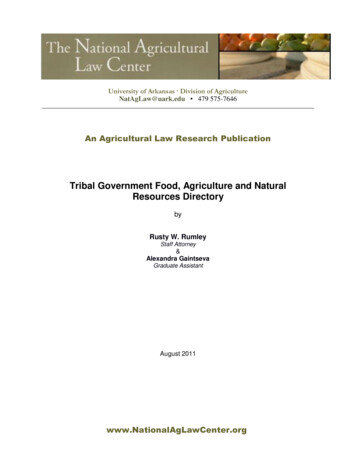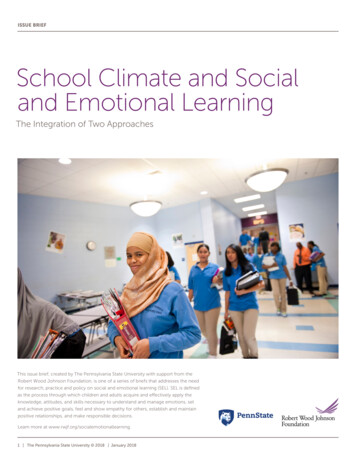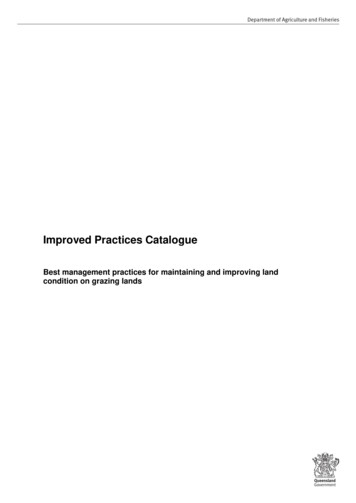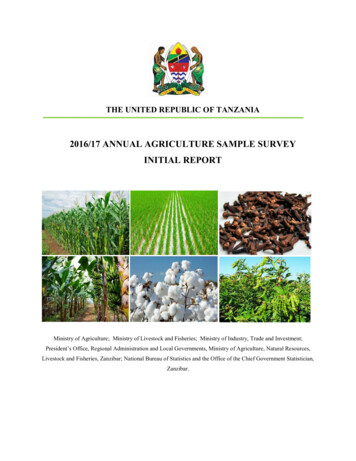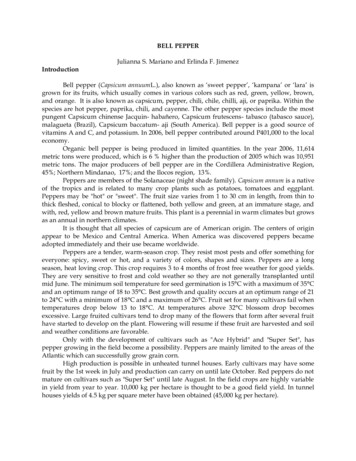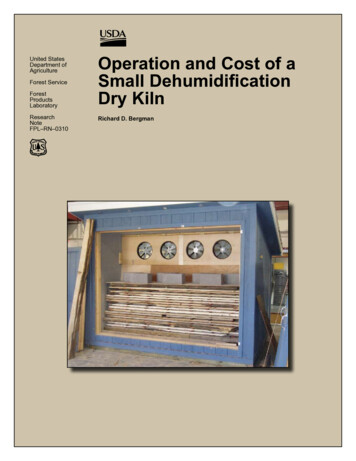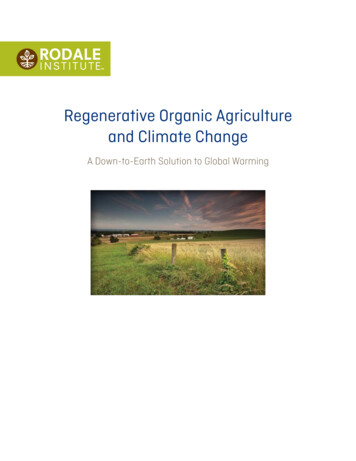
Transcription
Regenerative Organic Agricultureand Climate ChangeA Down-to-Earth Solution to Global Warming
At Rodale Institute, we have proven that organic agriculture and,specifically, regenerative organic agriculture can sequester carbonfrom the atmosphere and reverse climate change.This document outlines those findings.Regenerative organic agriculturerefers to working with nature to utilizephotosynthesis and healthy soilmicrobiology to draw downgreenhouse gases.“Regenerativeorganic agriculturecan sequestercarbon and reverseclimate change.”With the use of cover crops, compost, crop rotation and reducedtillage, we can actually sequester more carbon than is currentlyemitted, tipping the needle past 100% to reverse climate change.We know that agriculture has played a role in creating climate chaosbut, now, with your help, it can be part of the solution.As pioneers in organic agriculture, Rodale Institute is poised to leadfarmers into this new era and we look forward to working with you toshare our research and technology throughout the world.Sincerely,Mark SmallwoodExecutive Director1
All this flows from the failure to look beyond the source of the problem, namely, the swarmingcarbon pumps that endlessly contaminate our atmosphere. The purpose of this paper isto redirect the discussion from the “swarm” to the “simple.” We suggest an obvious andimmediately available solution – put the carbon back to work in the terrestrial carbon “sinks”that are literally right beneath our feet. Excess carbon in the atmosphere is surely toxic tolife, but we are, after all, carbon-based life forms, and returning stable carbon to the soil cansupport ecological abundance.Simply put, recent data from farming systems and pasture trials around the globe show thatwe could sequester more than 100% of current annual CO2 emissions with a switch to widelyavailable and inexpensive organic management practices, which we term “regenerativeorganic agriculture.” These practices work to maximize carbon fixation while minimizing theloss of that carbon once returned to the soil, reversing the greenhouse effect.Regenerative organic agriculture for soil-carbon sequestration is tried and true: Humanshave long farmed in that fashion, and there is nothing experimental about it. What is new isthe scientific verification of regenerative agricultural practices. Farming trials across theworld have contrasted various forms of regenerative and conventional practices with specialattention to crop yield, drought impact, and carbon sequestration. Some of these studies are24,5681,4009063,264 190 558The key term in the above paragraph is “net.” Gross greenhouse gas emissions come fromnumerous man-made sources. The resulting climate chaos has begun to modify our planet inways that are not fully understood, leading to natural emissions that add to the complexity ofthe challenge. If we continue to attack the climate crisis solely from the direction of reducinggross manmade emissions, we will be forced to confront all the bewildering complexityof climate chaos. We will also be forced to battle carbon pumps everywhere – industrial,agricultural, the transportation sector – and from every direction on the globe. We will be forcedto ask what countries should bear what responsibility, what industries should bear what portionof the blame and burden, and who should pay for the sacrifices we tremble to imagine? Thisdaunting challenge is posed by trying to solve the problem by addressing only the “pump,” andit has led to international bickering, incoherence, and inaction. People are left to pray for a yetundiscovered “technological messiah” to undo the damage, for our political will is paralyzed.4,022We are at the most critical moment in the history of our species, as man-made changes tothe climate threaten humanity’s security on Earth. In 2012, total annual global emissions ofgreenhouse gases were approximately 52 GtCO2e. These emissions must soon drop to a net of41 GtCO2e if we are to have a feasible chance of limiting warming to 1.5 C, above which point wedare not pass.in their third decade of data, suchas this Institute’s Farming SystemsComparison of FSTTrial, and there are important freshOrganic and conventional systemslooks such as in the new TropicalFarming Systems Trial (“TFST”) on5000the Caribbean slope of Costa Rica.The TFST is exactly the type of4000research needed for us to understandthe full sequestration potential3000of regenerative agriculture, andRodale Institute is pleased to be2000collaborating with local researchersassociated with Finca Luna Nuevaand EARTH University. Taken1000together, the wealth of scientificsupport for regenerative organic0yieldsprofitenergygreenhouseagriculture has demonstrated that(lbs/a/yr)( /a/yr)inputgases(MJ/a/yr)(lbs co /a/yr)these practices can comfortably feedthe growing human population, whilelbs pounds a acrey r year MJ megajoulerepairing our damaged ecosystem.This scientific support has also ledthe United Nations Commission onTrade and Development (“UNCTAD”) to issue, in September, 2013, a report “Wake Up Before It’sToo Late,” a powerful call for the return to these sustainable practices.4,079Executive Summary2Developing a comparable set of global farming system trials designed to more specificallymeasure carbon sequestration is our best hope for demonstrating the power of regenerativeorganic agriculture to help solve the climate equation. At the same time, these trials will act ashubs of skills incubation and support networks for farmers already working in, or transitioningto, regenerative organic models.Today there are farmers and agricultural scientists in every corner of the world committedto and excited about the results of regenerative organic agriculture’s role in reversingboth climate issues and food insecurity, and the specific research needs have been welldocumented. Now is the time to harness cutting-edge technological understanding, humaningenuity and the rich history of farmers working in tandem with the wisdom of naturalecosystems. Now is the time to arrive at a stable climate by way of healing our land andourselves - through regenerative organic agriculture.UNCTAD titled its report on regenerative farming “Wake Up Before It’s Too Late.”This paper is the massive awakening.3
Regenerative Organic Agriculture and Climate ChangeA Down-to-Earth Solution to Global WarmingSolving the long-term climate equation means getting to a zero carbon economy devoid offossil fuels. It is widely acknowledged that we are not going to arrive at a new low-carboneconomy any time soon; the technologies, markets, political and social structures needed toshift the world’s economies are not materializing quickly enough.1 In the decades it will taketo decarbonize the economy, an unacceptable level of warming will become locked in.2 Witheach passing year of inaction, hope for our planet’s future becomes harder and harder to rally.We are on a trajectory of too little too late. If we wait, our only hope for the future lies in yetto-be-discovered technological fixes coupled with the loss of whole cultures and species. Thenumbers are so sobering that untested technologies for carbon capture and storage have inshort order gone from unsafe, outlandish whims to pressing societal needs: bioengineering thehuman body has even entered the climate conversation.And yet, there is hope right beneath our feet. There is a technology for massive planetarygeoengineering that is tested and available for widespread dissemination right now. The costis minimal and is adaptable to local contexts the world over. It can be rolled out tomorrowproviding multiple benefits beyond climate stabilization. The solution is farming. Not justbusiness-as-usual industrial farming, but farming like the Earth matters. Farming like waterand soil and land matter. Farming like clean air matters. Farming like human health, animalhealth and ecosystem health matters. Farming in a way that restores and even improvesour soil’s natural ability to hold carbon. This kind of farming is called regenerative organicagriculture and it is the short-term solution to climate change we need to implement today.We don’t have to wait for technological wizardry: regenerative organic agriculture cansubstantially mitigate climate change now.On-farm soil carbon sequestration can potentially sequester all of our current annual globalgreenhouse gas emissions of roughly 52gigatonnes of carbon dioxide equivalent( 52 GtCO2e). Indeed, if sequestrationrates attained by exemplar cases wereachieved on crop and pastureland acrossthe globe, regenerative agriculturecould sequester more than our currentannual carbon dioxide (CO2) emissions.Even if modest assumptions about soil’scarbon sequestration potential are made,regenerative agriculture can easily keep4Rodale Institute Farming Systems Trial5
annual emissions within the desirable lower end ofthe 41-47 GtCO2e range by 2020, which is identifiedas necessary if we are to have a good chance oflimiting warming to 1.5 C.2Soils in the organic andconventional plots are verydifferent in appearancedue to the increase insoil organic matter in theorganically managed soils.The organically managed soilis darker and aggregates aremore visible compared to theconventionally managed soil.But agriculture as it is practiced today acrossmost of the world is not part of the solution; it is,instead, part of the problem. Rather than mitigatingclimate change, it is a net producer of greenhousegas emissions both directly through conventionalfarming practices that deplete soil carbon stockswhile emitting nitrous oxide (N2O), and indirectly through land-usechange.3 In addition, the intensification of livestock production andrice paddy agriculture has exacerbated release of the greenhousegas methane (CH4). Since the dawn of farming, most agriculturalsoils have lost from 30% to 75% of their original soil organiccarbon.4 With the widespread modernization of farming in themid-20th century, contemporary agricultural practices, such assynthetic nitrogen fertilization, tillage, monocropping, and yieldbased management systems, have accelerated the depletion ofsoil carbon stocks adding to the human-induced, or anthropogenic,atmospheric load of N2O and CO2.3,5 Over the past decade, thesedirect agricultural emissions have increased about one percent ayear, reaching 4.6 Gt CO2 yr-1 in 2010, or about 10% of total annualemissions.6 Although, direct emissions are not the whole picture.The food system at large, including feed, fertilizer and pesticidemanufacture, processing, transportation, refrigeration andwaste disposal, accounts for 30% or more of total annual globalgreenhouse gas emissions.7What is Regenerative Organic Agriculture?Regenerative organic agriculture improves the resources it uses, rather than destroying ordepleting them. It is a holistic systems approach to agriculture that encourages continual onfarm innovation for environmental, social, economic and spiritual wellbeing.10Robert Rodale, son of American organic pioneer J.I. Rodale, coined the term ‘regenerativeorganic agriculture’ to distinguish a kind of farming that goes beyond simply ‘sustainable.’Regenerative organic agriculture “takes advantage of the natural tendencies of ecosystemsto regenerate when disturbed. In that primary sense it is distinguished from other types ofagriculture that either oppose or ignore the value of those natural tendencies.”11 Regenerativeorganic agriculture is marked by tendencies towards closed nutrient loops, greater diversity inthe biological community, fewer annuals and more perennials, and greater reliance on internalrather than external resources.11 Regenerative organic agriculture is aligned with forms ofagroecology practiced by farmers concerned with food sovereignty the world over.12,13Improved management of agricultural land with known, low-costpractices has the potential to both reduce net greenhouse gasemissions and to act as a direct CO2 sink.3,8 Moving agriculturefrom a source of carbon pollution to a potential carbon sink is ineveryone’s best interest. Agriculture that sequesters carbon isalso agriculture that addresses our planetary water crisis, extremepoverty, and food insecurity while protecting and enhancing theenvironment now and for future generations.9 Regenerative organicagriculture is the key to this shift. It is the climate solution ready forwidespread adoption now.Robert Rodale67
Changing farming practices to organic, regenerative and agroecological systems can increasesoil organic carbon stocks, decrease greenhouse gas emissions,14 maintain yields,15,16 improvewater retention and plant uptake,17 improve farm profitability,16 and revitalize traditionalfarming communities18 while ensuring biodiversity and resilience of ecosystem services.17,19Regenerative organic agriculture is also integral to the climate solution.The Reversal Capability of Regenerative OrganicAgricultureTotal global emissions of greenhouse gases in 2012 were about 52 GtCO2e.2 Annual emissionsmust drop to 41 GtCO2e by 2020 if we are to have a feasible chance of limiting warming to1.5 C.2 Regenerative organic agriculture can get us there. Simply put, recent data from farmingsystems and pasture trials show that we could sequester more than 100% of current annualCO2 emissions with a switch to widely available and inexpensive management practices.Total global emissions potentially sequestered through regenerative agricultureGlobal pastureThailand crop37Gt CO2 yr-132Egypt cropIran crop2121U.S. crop12If management of all current cropland shifted to reflect the regenerative model as practicedat the Iranian or Egyptian sites (see figure 1 and table 1), we could potentially sequester morethan 40% of annual emissions (an estimated 21 GtCO2 each year). If, at the same time, allglobal pasture was managed to a regenerative model, an additional 71% ( 37 GtCO2) might besequestered,1 bringing us into an annual negative emissions scenario rap
We know that agriculture has played a role in creating climate chaos but, now, with your help, it can be part of the solution. As pioneers in organic agriculture, Rodale Institute is poised to lead farmers into this new era and we look forward to working with you to share our research and technology throughout the world. Sincerely, Mark Smallwood Executive Director “Regenerative organic .

